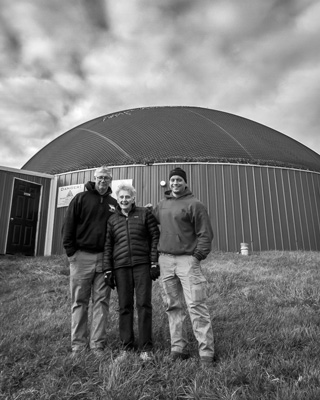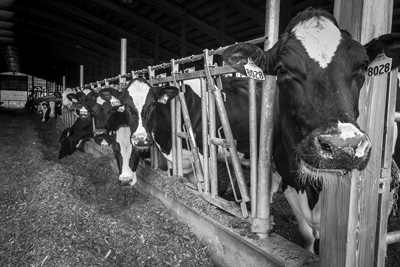News & Issues December 2017-January 2018
Cow power
Manure-to-energy systems could aid farms, environment, but few in N.Y. opt in
 Three generations of the Wagner family -- Peter, Louise and Keith Wagner -- stand in front of the anaerobic biodigester at their dairy farm in Brunswick, N.Y. The device converts cow manure and other agricultural wastes into methane that can be burned for heat and power. Joan K. Lentini photo
Three generations of the Wagner family -- Peter, Louise and Keith Wagner -- stand in front of the anaerobic biodigester at their dairy farm in Brunswick, N.Y. The device converts cow manure and other agricultural wastes into methane that can be burned for heat and power. Joan K. Lentini photo
By EVAN LAWRENCE
Contributing writer
Vermont launched a program nearly 15 years ago that pays farmers to generate electricity from cow manure, and today the state’s Cow Power program generates enough power for 3,200 homes.
A similar program has taken off in Massachusetts in recent years, with a series of large dairy farms installing anaerobic waste digesters that break down manure and other agricultural and food wastes into methane that can be burned to generate power.
But despite the significant concentration of dairy farms in Washington, Rensselaer and eastern Saratoga counties, farmers in eastern New York have been discouraged by low power prices that make it difficult for the expensive waste-digesting systems to break even.
“One of the big factors is an agreement with the power company,” said Aaron Gabriel, crops and soils educator at Cornell Cooperative Extension in Washington County.
Gabriel said he knows of only two farms in eastern New York, one in Washington County and one in Rensselaer County, that have installed anaerobic waste digesters.
Now a state legislator from eastern New York is seeking to boost the idea of generating more power from farm wastes. Assemblywoman Carrie Woerner, D-Round Lake, is proposing legislation that would require utilities to pay “fair market value” for power produced by farm-based manure-digesting systems.
Woerner’s district covers portions of Washington and Saratoga counties and includes many dairy farms. She and other supporters say increased use of waste-digesting systems would help farms cut their energy costs, reduce odors and pollution from agriculture runoff, and curb atmospheric releases of methane, a powerful greenhouse gas.
Digesters “take methane out of the equation, which reduces greenhouse gases and produces power,” Woerner said. “I think that’s something we should be encouraging. But we’re not able to recognize the opportunity of this technology, because the Public Service Commission doesn’t require distributors to pay a fair market price.”

How the system works
Anaerobic waste digesters collect manure and other organic material, heat it, and allow naturally occurring bacteria to break down the waste in an oxygen-free tank. As pumps move manure through the tank, the bacteria release methane, which can be collected and burned for heat or to run a generator.
And because methane is a more potent greenhouse gas than carbon dioxide, the digester greatly reduces the farm’s impact on the atmosphere.
After three to four weeks, the remaining sludge is separated into liquid and fibrous solids that have become odor-free. The liquid can be sprayed on fields as a fertilizer. The heat of the digester kills pathogens in the solids, which can be returned to the barn as fluffy bedding or sold as nutrient-rich compost.
Supporters say the system offers an environmentally friendly solution for large dairy farms that produce lots of manure.
Farms that confine their animals for more than a certain number of days a year are required by federal environmental regulations to have a manure management plan. Although farmers can spread raw manure directly onto fields, the nutrients may be lost if the ground is wet or frozen and the manure runs off. This results in pollution to surface and ground water, and neighbors may find the odor offensive.
Anaerobic digesters, in contrast, allow farmers to process cow wastes into a form that can be stored more easily while reducing air and water pollution, cutting some expenses, and possibly generating some income to help pay for the system.
Green Mountain Power, the utility that delivers most of Vermont’s electricity, estimates that a digester-generator system costs about $1,400 per cow. To make such a system economically feasible, farmers may need loans and grants -- and a good rate for the power they produce.
Supportive power company
Central Vermont Public Service, which merged with Green Mountain Power several years ago, started its Cow Power program in 2003.
Through the program, utility customers who want to support renewable energy from anaerobic digesters have the option of paying an extra 4 cents per kilowatt-hour on all or a portion of their electric bills. Farmers receive a fair market price for the electricity they produce as well as funds from the 4-cent tariff. Green Mountain Power doesn’t make money on the program.
The first farm to sign up was Blue Spruce Farm in Bridport. With help from a consultant from the utility, the farm installed its digester in 2004 and started generating power in early 2005.
Green Mountain Power spokeswoman Dorothy Schnure said the program now includes dairy farms around the state. It’s supported not only by residential customers but also by a number of businesses and nonprofits.
Killington Resort, for example, buys cow power to run its gondola and peak lodge, Schnure said. Other supporters include Middlebury and Green Mountain colleges, Long Trail Brewing Co., and the Vermont Community Foundation. Middlebury College recently announced that it would buy methane piped from a nearby dairy farm’s digester to run the college’s power plant.
“One of the really great things about digesters is the dried bedding,” Schnure said.
Using dried solids from the digester as bedding for animals means “farmers don’t have to buy” bedding, a major expense on dairy farms, she explained.
Schnure said she knew of no farms that have dropped out of the program, which includes 14 of the state’s 800 dairy farms.
“It’s a great success story,” she said.
In Massachusetts, Pine Island Farm in Sheffield was among the first dairy farms in the state to install an anaerobic digester in 2011. The farm, owned by the Aragi family, has 1,500 cows and is the largest dairy operation in the state. The farm installed a second generator this year.
In Massachusetts, sales of cow power to the electric grid are supported by a state system of renewable energy credits. The state has 155 dairy farms.
Three years ago, Massachusetts began barring commercial food producers from sending organic wastes to landfills. The intent of this new requirement was to boost composting operations, but some supermarkets and food processors are instead sending their wastes to farms that have digesters.
At farms like Pine Island, the food wastes – everything from whey from dairy processing to grains from beer making – can be added to manure to make more methane.
New York pioneer
Wagner Farms is one of the two farms in eastern New York that have anaerobic waste digesters. The 400-cow dairy farm near Poestenkill installed its system in late 2010.
The farm’s owners say they wanted a better way to manage manure and reduce odors while saving money on animal bedding and electricity. Wagner Farm’s digester also generates income from the sale of surplus post-digester solids and electricity.
The farm was able to take advantage of a New York State Energy Research and Development Authority program, no longer available, that paid an incentive for power produced in the digester’s first three years of operation.
The digester was the subject of a Cornell University manure management program case study in 2014. The Wagner Farms digester includes features to remove hydrogen sulfide, a natural by-product of manure decomposition, from the gases that accumulate at the top of the digester tank. The caustic gas otherwise could damage the generator.
Keith Wagner manages the digester for the farm and said the smoothness of the operation varies.
“It has its good days and its bad days,” he said. “The good days outnumber the bad ones.”
Although the cost of the digester was a big hurdle, Wagner said his family also found that learning to operate the system was another challenge.
“Getting into a digester, you don’t know much about it,” Wagner said. “There’s a large learning curve.”
The Wagners have found that in the summer, the system generates excess power that the farm sends to the grid. The farm’s electrical utility, National Grid, pays only 3 cents per kilowatt-hour, “well below market value,” Wagner said.
In the winter, “we break even or spend money on electricity,” he added.
The power company was not eager to deal with the system, he said.
“The best thing about the digester is the bedding solids,” Wagner said. “It’s cooked and pasteurized, and the cows like it.”
When the Wagners installed the system, New York’s energy policy was based on standards that encouraged renewable energy development. But that policy is under review, and changes may be pending, Wagner said.
Although the state’s goal now is to obtain 50 percent of its electricity from renewable sources and to reduce greenhouse gases by 40 percent by 2030, it’s not clear whether the state’s new policies will favor the economics of power generated from anaerobic digesters.
Generators can be tricky to run and expensive to maintain. If the revenue from a generator falls below the break-even point, however, farmers don’t have to use it. They can capture the methane produced by the digester and burn it to supply heat to the digester tank and other equipment – or they can just burn it off, a process called flaring.
An option for more farms?
Steve Ammerman, a spokesman for the Farm Bureau of New York, said digesters have clear benefits for farms, but the number of farms able to afford them under current rules may be limited.
New York has about 4,600 dairy farms and 620,000 cows, but no more than a few dozen farms statewide are believed to be generating electricity with anaerobic digesters.
“We’re supportive of farms that have anaerobic digesters,” Ammerman said. “They’re one way to invest in energy for farms. They’re environmentally friendly, a way of dealing with methane and food wastes, and they make bedding.”
But, he noted, “they have a significant capital investment and upkeep costs.”
The state’s focus now is on issuing manure management permits for concentrated animal feeding operations, or CAFOs, which includes most large dairy farms, Ammerman said. The state has funds to help farmers with manure storage, but not specifically aimed at installing digesters.
Woerner said her proposal – to require utilities to pay a fair market price for electricity put on the grid by anaerobic digesters – is well justified because farm-based methane-burning generators are in some ways more reliable than solar and wind power.
“Power from digesters is different from other forms of green energy,” Woerner said.
In contrast to solar and wind, which are intermittent and weather-dependent, “you know how many cows you have, how much they eat, and how much they poop,” Woerner explained.
“You can predict very accurately how much power they’ll produce and put on the grid,” she said. “They’re a base producer. Utilities know how much they need to meet peak demand. If they know how much digesters are producing, they know how much less power they’ll have to buy on the open market.”
Woerner said she plans to introduce her legislation in January.
“We should be investing in all forms of renewable energy,” she said.
